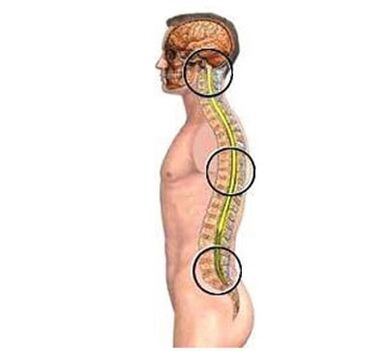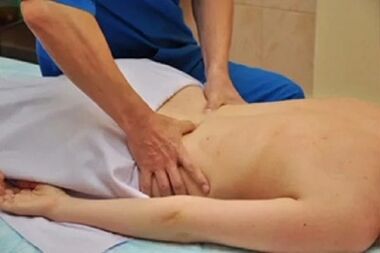Osteochondrosis is one of the most common, well-studied but difficult-to-treat musculoskeletal disorders. It’s not just back pain and a lot of discomfort: over time and left untreated, osteochondrosis can lead to severe deformities and significantly reduce a patient’s standard of living. Therefore, it is very serious to take this seemingly fearless disease at the first signs.

Symptoms
Osteochondrosis remains undiagnosed for a very long time. The syndromes of osteochondrosis cannot even refer directly to the spine, disguising themselves as another disease. And the patient "pauses" the pain syndrome with a painkiller, blaming everything for the migraine - at best, at worst - for a completely different disease, not seeing improvement for years.
In the early stages of the disease, osteochondrosis occurs with only minor pain and discomfort, intense physical activity, or sitting at a table in a long, uncomfortable position. The disease develops over the years, gradually all the symptoms increase. Characteristics of osteochondrosis of the thoracic region include:
- numbness and tingling in the limbs. With an especially long stay in a situation or after sleep. This is one of the first signs of spinal problems. After rubbing, numbness and discomfort disappear quickly and do not cause severe discomfort;
- feeling cold, bulge on the skin in the hands, often in the affected area of the hand or individual fingers, less commonly
- painful feelings often have a "bad" localization. Pain can occur in both the affected area of the spine and radiate (give) to the chest area, which is similar to the pain of heart disease when breathing. Therefore, when diagnosing osteochondrosis in the presence of pain in the heart region, an ECG will be a mandatory test - to rule out ischemic diseases. In addition, pain is often applied to the shoulder blade (intercostal neuralgia) or left hand area;
- painful feelings often intensify at night;
- the patient is often afflicted with a migraine-like headache. They can occur on one side of the head and cover the entire head;
- general decrease in well-being, mood;
- osteochondrosis of the thoracic region is rarely accompanied by compression of the spinal cord. But if this happens, the symptoms will be more pronounced: the feelings of pain will intensify, accompanied by severe disturbances in the work of the internal organs.
All symptoms of osteochondrosis are the result of compression of nerve roots passing along the spinal column. Depending on the area and the degree of compression, the symptoms can be very varied, so if the first suspicion of osteochondrosis is, it is very important to perform instrumental examinations and make the correct diagnosis.
Chest osteochondrosis alone is rare - the chest region is inactive and less stressful, most often this disease is combined with cervical osteochondrosis.
Osteochondrosis treatment methods
Like all degenerative diseases of the musculoskeletal system, osteochondrosis is very difficult and long-term to treat - there is no easy and quick cure. You need to be prepared for this. It is impossible to reverse degenerative changes in intervertebral discs. The ideal option is to stop the development of the disease in the initial stage, when osteochondrosis does not impose any restrictions on the patient’s lifestyle. In the earliest stages, it is enough to slightly modify the patient's lifestyle: increase physical activity, complete the diet. But it is extremely rare to make a diagnosis at the very beginning of the pathological changes.
The traditional therapeutic complex for osteochondrosis includes:
- Drug therapy. . . It consists of several components:
- with severe pain syndrome, the patient is prescribed an analgesic. Most often, these are non-steroidal anti-inflammatory drugs (NSAIDs). Steroidal anti-inflammatory drugs, opiates and opioids are used less frequently. They are stronger, but there are a number of restrictions on their use;
- taking bone supplements and vitamins as a mandatory part of treatment;
- muscle relaxants help relieve muscle tension. But it must be said that without the continuous practice of medical gymnastics, the use of muscle relaxants is strictly contraindicated;
- taking condoprotectors helps speed up recovery processes in the affected area, although the attitude of professionals to such drugs is very ambiguous.
- Drug-free treatmentmore important in the successful treatment of osteochondrosis.
- it should focus primarily on the systematic and correct implementation of the physiotherapy complex. The goal of movement therapy is to strengthen the ligament around the spine, speed up local blood circulation, and with regular exercise can significantly improve the patient’s condition;
- Physiotherapy treatments help relieve muscle pain and tension. They act in the same way as anti-inflammatory painkillers, but have far fewer contraindications;
- massage. Both traditional therapeutic massage and a number of alternative methods are practiced, the main selection criteria being the professionalism of the specialist and consultation with the treating physician;
- hand therapy;
- traction (traction therapy) on a special simulator. The gentle adhesion of the spine makes it possible to relieve muscle tension and reduce the symptoms caused by the compression of nerve roots;
- you need to change your approach to your diet, make it more balanced.

Therapeutic exercises for osteochondrosis of the thoracic region
You can do a medical gymnastics both in the special room of the hospital and at home. The more frequent and regular the sessions, the greater the efficiency. It is advisable to drive classes several times a day, the morning exercises are a mandatory part of the complex. Each workout should last from 5 (in the first stage) to 40 minutes, with repetitions of each exercise from 5 to 20. Here is an approximate series of exercises:
- Lie on your back, the surface should be flat and solid, you can lay a gym mat for comfort. Bend your knees and then simultaneously stretch your knees towards your nose and your head towards your knees. Hold for a few seconds at the top point, return to the starting point, change your leg;
- Universal practice - from a childhood "cat" familiar to everyone. Stand in fours with your head down. When inhaling, bend your back as much as possible and raise your head. Then, on exhalation, arch your back and lower your head;
- In the middle of the work day, you can take a break for a simple exercise: alternately raise both shoulders as high as possible while one shoulder rises and the other goes down;
- Sit down on a chair with the backrest reaching for your shoulder blades (a standard office chair will do), pressing your back firmly against the back of the chair. Then raise your arms and bend your upper back as much as possible;
- With outstretched arms, make several circular motions as wide as possible. Do this while sitting or standing on a straight hard chair;
- Stand up straight with your feet shoulder-width apart. Lock the back under the shoulder blades. Bend back as much as possible in the chest region, resist yourself with your hands;
- Also, from a standing position, as much as possible, hunched over, chin to chest, shoulders bent towards each other. Hold in the lowest position for a few seconds. Then perform the back movement: straighten your shoulders as much as possible, bring your shoulder blades together and throw your head back. The exercise is performed at a slow and smooth pace.
The development of osteochondrosis in the thoracic region may develop very slowly without causing much concern for a long time, but as a result, the patient faces a number of restrictions on his or her normal lifestyle and the fact that living standards are steadily declining. Therefore, if you experience the first discomfort and mild pain, you should consult a doctor.






















